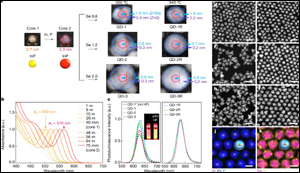Samsung researchers: More efficient quantum dots without heavy metals
2. 12. 2019 | Phys.org | www.phys.org
A team at Samsung Advanced Institute of Technology has announced that they have improved quantum dot (QD) technology for use in large displays by developing QDs that are both more efficient and have no heavy metals.
Quantum dots are nanoscale semiconducting crystals that have unique optical and electronic properties due to quirks of quantum mechanics. Since their development in the 1980s, scientists have been finding many uses for them in optical devices. But unfortunately they suffer from two problems that have prevented them from being fully utilized. The first is that they are based on cadmium, a toxic heavy metal. The second is the QD phosphors that are used in display devices—they are not self- emissive, which means they need to be replaced by QD light-emitting diodes in order for them to be competitively efficient.

The new approach by the researchers involved using a new structure that stops oxidation from degrading the QD core—it also involved creating a shell around it to keep energy from leaking out. The researchers report that their changes improved quantum efficiency by 21.4 percent—and increased QD lifetime by approximately a million hours.
Read more at Phys.org
Image Credit: Nature
-jk




